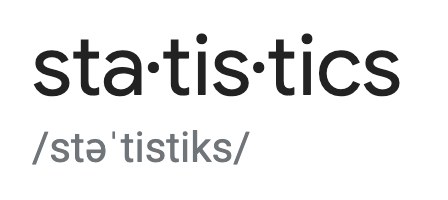It’s World Statistics Day.
Did you know that 93.7% of all internet users will believe nearly 98% of anything reported with a percentage sign? We actually just made those numbers up, but you’re probably not going to fact check us, so what difference does it make?
That’s actually a great question: What difference does it make?
Well, made-up, out-dated, or non-specific data doesn’t make a difference — not long-term, anyway. So, what does? What actually makes a long-term, lasting, meaningful, and real difference when it comes to marketing?
Real statistics.
Real data.
Statistical data.
Real statistics.
Real data.
Statistical data.

The dictionary definition of “statistics” is the practice or science of collecting and analyzing numerical data in large quantities, especially for the purpose of inferring proportions in a whole from those in a representative sample. But you already know that.
What you might not know is how that definition applies to your product or business.
Let’s say you have a new business with a better-than-average product to sell — a burger restaurant, for example, that serves an absolutely delicious hamburger! You only use the finest, Grade-A beef; the farm-freshest toppings from local farms; and your buns are hand-crafted and fresh-baked every single morning using a recipe passed down from your great-great-grandmother. She used to bake breads for Rutherford B. Hayes, which is why you named your restaurant “Rutherford’s.”

So, you’ve got a great product and a great story to tell. What’s next?
Well, you need to tell your story, and you need to tell it well, but that still doesn’t mean people will come eat it — your hamburger, we mean… not the story.
In order to get people to come to Rutherford’s, you need to tell the right story to the right people at the right time. At blu, we use statistical data to develop a comprehensive plan for targeting receptive recipients before we start telling the story. Here’s how that works:
Imagine you have a total of 50 available customers to market to within your area, but we only have enough budget to reach 10 of them. Which 10 should you target? Using data, blu is able to determine that 11 of those individuals are vegetarians; 11 of them are highly competitive athletes with very strict diets; 8 people in your area have medical conditions that restrict their ability to eat red meat; and based on recent purchasing behaviors, we know that 10 others are 80% more likely to eat chicken over beef.
Using statistical data, we have now been able to determine that 40 out of your 50 available customers are brand-resistant, leaving just 10 highly likely targets who are hungry for your story. See what we did there?
Anyway, the point we’re making is this: Data matters. Statistics are real. And when armed with these crucial numbers and real-life percentage signs, blu can help make a real-life difference in your marketing promotions and in the results you require — not just to stay in business, but to thrive. Just imagine all the burgers you’ll sell!
Stop guessing and start Knowing with blu.
When it comes to your business, it’s time to stop guessing and start KNOWING. At blu, we give you the power to find (and get to know) the right people in the right places at the right times. We provide the vision and insight you need to identify your best customers; to target the people most likely to be impacted; and then focus on the best ways to be seen, heard, and understood by the people who matter most — YOUR FUTURE CUSTOMERS. Contact us today if you are ready to dive into statistics that will increase your bottom line.
Happy World Statistics Day, everybody.

